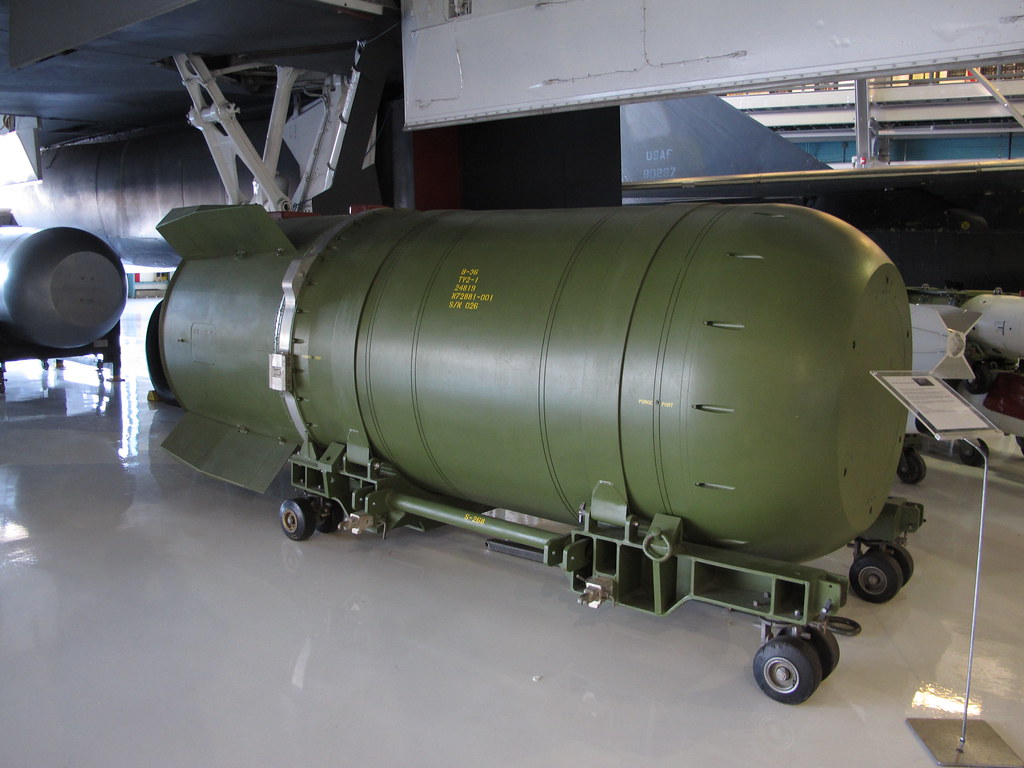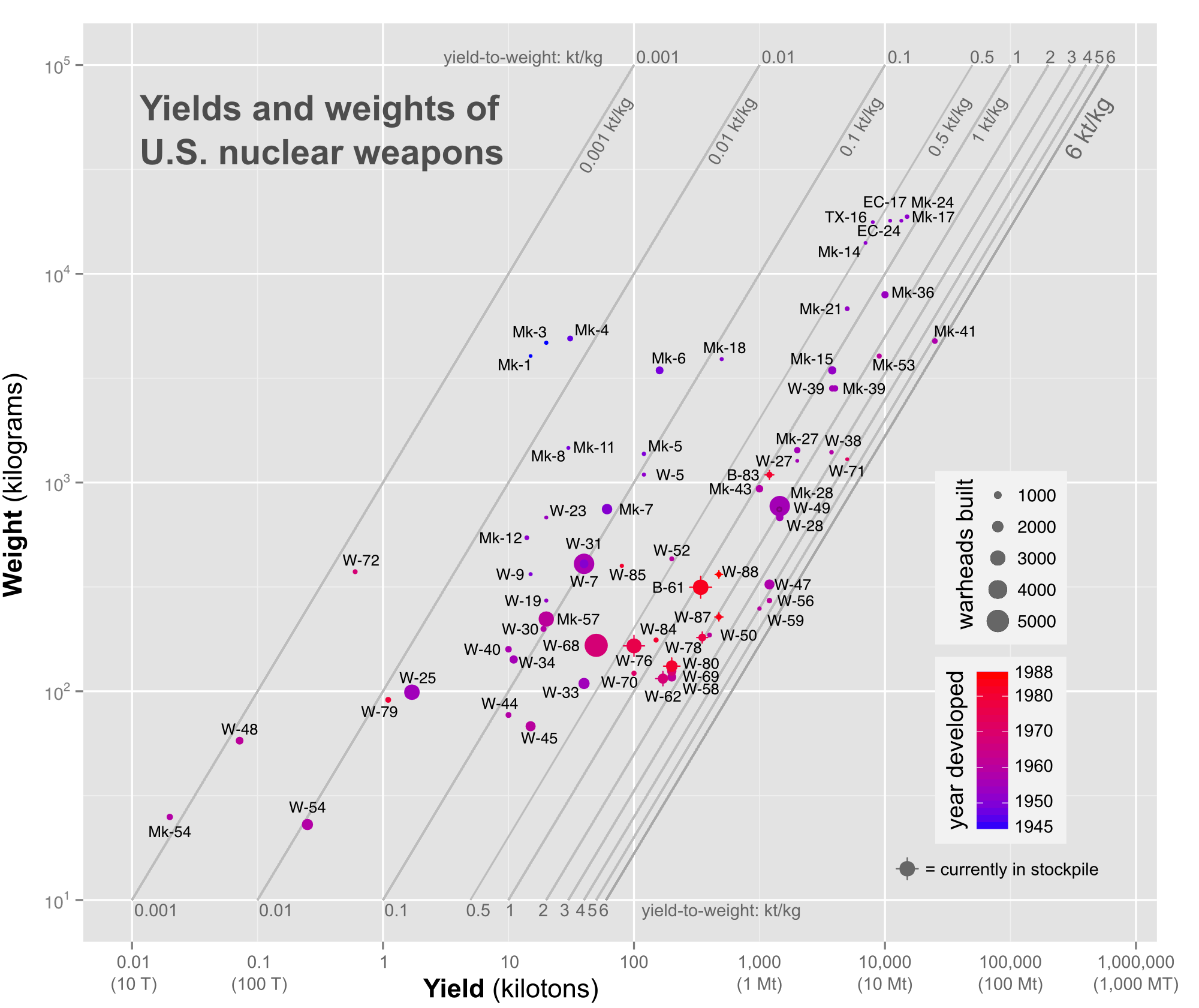Winston
Lorenzo von Matterhorn
- Joined
- Jan 31, 2009
- Messages
- 9,560
- Reaction score
- 1,749
Where does the "6 kiloton/kilogram" maximum achievable yield-to-weight ratio figure for nuclear weapons comes from?
Updated Nov 26, 2017
https://www.quora.com/Where-does-th...t-ratio-figure-for-nuclear-weapons-comes-from
This has been called the "Taylor limit" after an article in Scientific American: Third-Generation Nuclear Weapons, Scientific American, 4/1987, pp. 30-39) by physicist Ted Taylor who cited this value as a practical limit. Computing the reported weights and yields of known test devices and weapons confirms that no known device exceeds this.
The reason for the limit seems to be efficiency limits that exist in trying to compress a thick layer of fusion fuel without heating it up (which limits compression, and thus burn rate) in the time available before the bomb disassembles, and practical fusion tamper to fusion fuel mass ratios in a compact device. The amount of fusion you can get for given mass of fusion tamper limits the bomb yield to weight ratio.
As you mention, there is evidence that it can be exceeded.
And here, for the first time in public print anywhere, I will tell you how the design that the 1963 document alludes to works.
At the very end of the atmospheric testing period research in how to make very small fusion explosions (the earliest work in inertial confinement fusion) studied the optimal compression scheme for fusion fuel implosions.
To get the most efficient fusion fuel compression you need to compress the fuel with an exponentially increasing driving pressure. The problem is the pressure wave velocity depends on the pressure, so the long, low pressure phase takes a long time to transit to the center of the fuel mass. If it takes a long time the fission primary blows the bomb up before implosion is complete.
The way ICF fusion targets do it is to use a thin shell of fuel (thus the fuel mass is mostly empty space), and a carefully ramped up laser beam. The fuel shell gets highly compressed right at the start of the implosion, and stays that way during the high velocity collapse to the center.
So the Lawrence Livermore physicist doing this research, John Nuckolls, designed test devices that work this same way (though this was before any laser fusion experimental work had been done). The device design was called RIPPLE (I presume because to the pressure wave feature). There is an audio recording of President Kennedy being briefed on this breakthrough in July 1962, though 35 seconds are cut out where the technical details are described.
A large thin spherical shell of fusion fuel, and an energy barrier that initially leaked energy into the radiation case slowly was used.
This approach was first tested in the Pamlico shot (3.9 megatons) of Operation Dominic on 11 July 1962. A more sophisticated version, RIPPLE II, was tested in the Androscoggin shot of Operation Dominic on October 1, 1963 which fizzled due to a design error. After a hasty modification the design was retested in the Housatonic shot, which gave a yield 8.3 megatons on October 30. The YTW ratio for this last shot was 2.56 kt/kg, but did not represent the full potential of the design approach (and thus the possibility of a 35 Mt warhead on a Titan II). The tested designs were still preliminary and had been developed with limited resources on a very hasty schedule to get them into the Dominic series before it was closed.
This technology was never incorporated into a weapon though. Why? Because it requires a very large volume device. Modern ICBM RVs are needle-like cones, with very limited volume, so that they travel quickly in the atmosphere, and cruise missiles have limited diameters also.
Multiple warheads in cruise missiles, or MIRVed ICBMs use explosive energy more efficiently than giant single explosions, and are more flexible and versatile, so this is the direction in which nuclear weapon systems have evolved. Modern warheads actually only have ratios of ~2 kt/kg because there are more important things in design than how much explosion for how much warhead weight (survivability, safety, multiple fuzing options, variable yield, etc.).
[The link between LLNL ICF research and the Dominic test series was only published in the last few years.]
Test: Housatonic
Time: 16:01 30 October 1962 (GMT)
Location: Johnston Island
Test Height and Type: B-52 Airdrop; 12,130 Feet
Yield: 8300 kt
Device Diameter (inches): 56.2
Device Length (inches): 147.9
Device Weight (lb.): 7139.55
This LRL airdrop was the final nuclear weapon airdrop by the U.S. The device tested was a Ripple II in a Mk-36 drop case, and it was delivered with near-perfect accuracy (bombing error less than 100 feet). This was a repeat of the failed Androscoggin and was spectacularly successful, resulting in the highest yield of the Dominic test series. The yield-to-weight ratio was 2.56 kt/kg.


Updated Nov 26, 2017
https://www.quora.com/Where-does-th...t-ratio-figure-for-nuclear-weapons-comes-from
This has been called the "Taylor limit" after an article in Scientific American: Third-Generation Nuclear Weapons, Scientific American, 4/1987, pp. 30-39) by physicist Ted Taylor who cited this value as a practical limit. Computing the reported weights and yields of known test devices and weapons confirms that no known device exceeds this.
The reason for the limit seems to be efficiency limits that exist in trying to compress a thick layer of fusion fuel without heating it up (which limits compression, and thus burn rate) in the time available before the bomb disassembles, and practical fusion tamper to fusion fuel mass ratios in a compact device. The amount of fusion you can get for given mass of fusion tamper limits the bomb yield to weight ratio.
As you mention, there is evidence that it can be exceeded.
And here, for the first time in public print anywhere, I will tell you how the design that the 1963 document alludes to works.
At the very end of the atmospheric testing period research in how to make very small fusion explosions (the earliest work in inertial confinement fusion) studied the optimal compression scheme for fusion fuel implosions.
To get the most efficient fusion fuel compression you need to compress the fuel with an exponentially increasing driving pressure. The problem is the pressure wave velocity depends on the pressure, so the long, low pressure phase takes a long time to transit to the center of the fuel mass. If it takes a long time the fission primary blows the bomb up before implosion is complete.
The way ICF fusion targets do it is to use a thin shell of fuel (thus the fuel mass is mostly empty space), and a carefully ramped up laser beam. The fuel shell gets highly compressed right at the start of the implosion, and stays that way during the high velocity collapse to the center.
So the Lawrence Livermore physicist doing this research, John Nuckolls, designed test devices that work this same way (though this was before any laser fusion experimental work had been done). The device design was called RIPPLE (I presume because to the pressure wave feature). There is an audio recording of President Kennedy being briefed on this breakthrough in July 1962, though 35 seconds are cut out where the technical details are described.
A large thin spherical shell of fusion fuel, and an energy barrier that initially leaked energy into the radiation case slowly was used.
This approach was first tested in the Pamlico shot (3.9 megatons) of Operation Dominic on 11 July 1962. A more sophisticated version, RIPPLE II, was tested in the Androscoggin shot of Operation Dominic on October 1, 1963 which fizzled due to a design error. After a hasty modification the design was retested in the Housatonic shot, which gave a yield 8.3 megatons on October 30. The YTW ratio for this last shot was 2.56 kt/kg, but did not represent the full potential of the design approach (and thus the possibility of a 35 Mt warhead on a Titan II). The tested designs were still preliminary and had been developed with limited resources on a very hasty schedule to get them into the Dominic series before it was closed.
This technology was never incorporated into a weapon though. Why? Because it requires a very large volume device. Modern ICBM RVs are needle-like cones, with very limited volume, so that they travel quickly in the atmosphere, and cruise missiles have limited diameters also.
Multiple warheads in cruise missiles, or MIRVed ICBMs use explosive energy more efficiently than giant single explosions, and are more flexible and versatile, so this is the direction in which nuclear weapon systems have evolved. Modern warheads actually only have ratios of ~2 kt/kg because there are more important things in design than how much explosion for how much warhead weight (survivability, safety, multiple fuzing options, variable yield, etc.).
[The link between LLNL ICF research and the Dominic test series was only published in the last few years.]
Test: Housatonic
Time: 16:01 30 October 1962 (GMT)
Location: Johnston Island
Test Height and Type: B-52 Airdrop; 12,130 Feet
Yield: 8300 kt
Device Diameter (inches): 56.2
Device Length (inches): 147.9
Device Weight (lb.): 7139.55
This LRL airdrop was the final nuclear weapon airdrop by the U.S. The device tested was a Ripple II in a Mk-36 drop case, and it was delivered with near-perfect accuracy (bombing error less than 100 feet). This was a repeat of the failed Androscoggin and was spectacularly successful, resulting in the highest yield of the Dominic test series. The yield-to-weight ratio was 2.56 kt/kg.






